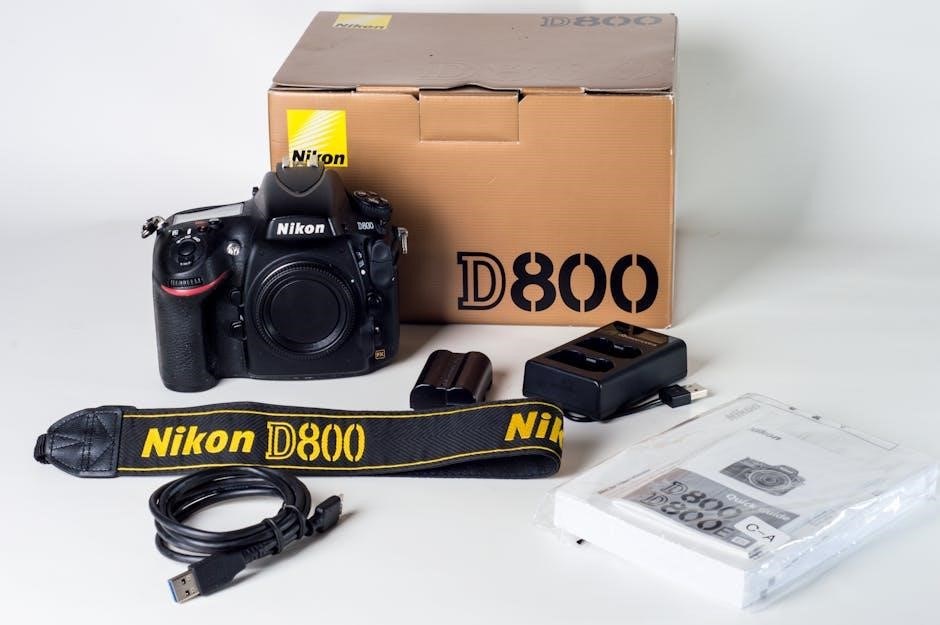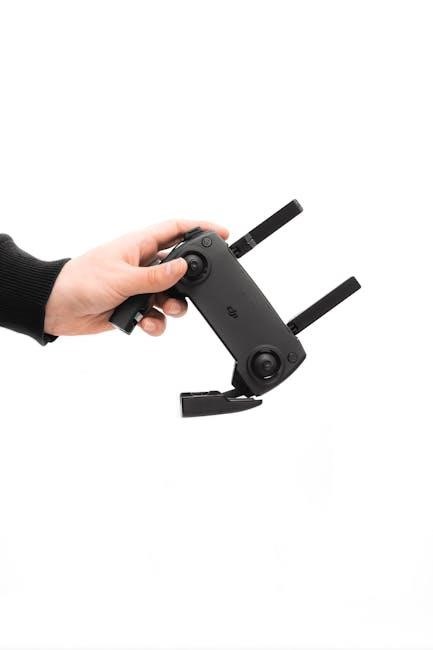yamaha cl5 user manual
Welcome to the Yamaha CL5 User Manual․ This guide provides essential information for installing‚ operating‚ and troubleshooting the Yamaha CL5 digital mixing console․
1․1 Overview of the Yamaha CL5 Mixing Console
The Yamaha CL5 is a professional digital mixing console designed for live sound‚ installation‚ and broadcast applications․ It features a compact design‚ intuitive interface‚ and advanced functionality․ With 32 + 8 faders‚ 72 mixing channels‚ and 8 DCA groups‚ the CL5 offers flexible control for complex audio setups․ Its high-resolution touch screen‚ customizable settings‚ and robust Dante networking capabilities make it a versatile tool for modern audio engineers․ The console is part of the CL Series‚ known for its reliability and superior sound quality․
1․2 Importance of Reading the User Manual
Reading the Yamaha CL5 User Manual is crucial for understanding its features‚ operation‚ and troubleshooting․ The manual provides detailed instructions for proper installation‚ configuration‚ and maintenance‚ ensuring optimal performance․ It covers panel controls‚ DCA groups‚ and advanced settings‚ helping users maximize the console’s capabilities․ Additionally‚ it includes troubleshooting tips for common issues like audio dropouts and firmware updates․ By following the manual‚ users can avoid operational errors and fully utilize the CL5’s potential․ Regular updates and resources are available on Yamaha’s official website for enhanced functionality․
How to Use This Reference Manual
This reference manual provides detailed instructions for Yamaha CL5 operations‚ including panel controls‚ connectivity options‚ and troubleshooting․ It is available in PDF format for easy access․
2․1 Navigating the Manual
Navigating the Yamaha CL5 Reference Manual is straightforward․ The manual is organized into sections‚ starting with an introduction‚ followed by operation guides‚ and ending with troubleshooting․ Users can easily locate specific topics using the table of contents or search function․ Hyperlinks within the document allow quick access to related sections․ The manual is available in multiple formats‚ including PDF‚ for offline use․ Regular updates ensure the latest features and fixes are covered․ This structure helps users efficiently find and understand the information they need to operate the CL5 effectively․
2․2 Searching for Terms and Using Hyperlinks
The Yamaha CL5 Reference Manual includes a robust search function‚ enabling users to quickly locate specific terms or topics․ Hyperlinks within the document provide direct access to related sections‚ streamlining navigation․ The manual is available in PDF format‚ allowing keyword searches and cross-referencing․ Users can also access additional resources‚ such as firmware updates and troubleshooting guides‚ through embedded links․ This feature enhances efficiency and ensures users can find the information they need swiftly and effortlessly while operating the CL5 mixing console․

Key Features of the Yamaha CL5
The Yamaha CL5 offers advanced features like the Selected Channel section‚ DCA groups‚ and user-defined settings‚ ensuring intuitive control and enhanced mixing capabilities for professional audio applications․
3․1 Panel Controls and Functions
The Yamaha CL5’s panel features intuitive controls‚ including faders‚ knobs‚ and buttons‚ designed for precise audio mixing․ The Selected Channel section provides access to detailed channel settings‚ while the Centralogic section offers a logical workflow․ The console includes DCA groups for custom control and user-defined settings for personalized configuration․ These features ensure efficient operation‚ catering to both live sound and studio applications․ The panel’s layout mirrors traditional analog mixers‚ making it familiar for experienced engineers․ Additional functions like scene management and preset recall enhance versatility and workflow efficiency․
3․2 DCA Groups and User-Defined Settings
The Yamaha CL5 offers customizable DCA (Digitally Controlled Amplifier) groups‚ enabling control over multiple channels simultaneously․ Engineers can assign DCA groups to manage subgroups like drums or vocals efficiently․ Additionally‚ user-defined settings allow personalization of faders‚ keys‚ and other controls‚ enhancing workflow․ These features provide flexibility and streamline mixing processes‚ making the CL5 adaptable to various live and studio applications․ The ability to tailor settings ensures optimal performance for diverse audio production needs․

Yamaha CL Series Comparison
The Yamaha CL series includes the CL5‚ CL3‚ and CL1‚ each differing in channel count and scalability․ The CL5 offers the highest capacity‚ while CL3 and CL1 provide compact solutions․
4․1 Differences Between CL5‚ CL3‚ and CL1 Models
The Yamaha CL5‚ CL3‚ and CL1 models vary in channel capacity and scalability․ The CL5 is designed for large-scale applications with up to 72 mixing channels‚ while the CL3 and CL1 are more compact‚ offering 48 and 32 channels‚ respectively․ The CL5 supports more DCA groups and custom settings‚ making it ideal for complex audio setups․ The CL3 and CL1 are tailored for smaller venues or mobile use‚ yet share the same core features like Dante networking and compatibility with Yamaha’s Pro Audio solutions․
4․2 Shared Features Across the CL Series
All CL models‚ including the CL5‚ CL3‚ and CL1‚ share core functionalities like Dante networking‚ digital I/O options‚ and compatibility with Yamaha’s Pro Audio solutions․ Each model supports DCA groups and user-defined settings‚ ensuring consistent operation across the series․ Firmware updates and comprehensive reference manuals are available for all models‚ maintaining optimal performance and user support․ These shared features ensure seamless integration and a unified experience for users‚ regardless of the specific CL model chosen․

Connectivity and Compatibility
The Yamaha CL5 supports both digital and analog connections‚ ensuring versatile integration․ Dante networking enables expanded audio options‚ while compatibility with Yamaha’s Pro Audio solutions enhances flexibility․
5․1 Digital and Analog Connections
The Yamaha CL5 offers a wide range of digital and analog connectivity options․ Digital connections include Dante networking‚ enabling seamless integration with compatible devices for expanded audio distribution․ Analog connections provide reliable XLR and TRS inputs and outputs‚ ensuring compatibility with traditional audio systems․ The console supports various sample rates‚ making it adaptable to different environments․ These features ensure the CL5 integrates effortlessly into both modern and existing audio setups‚ providing flexibility for diverse applications․
5․2 Dante Networking and Expansion Options
The Yamaha CL5 supports Dante networking‚ offering scalable audio distribution and integration with Dante-enabled devices․ Dante provides high-quality‚ low-latency audio transmission over IP networks․ The CL5 can manage up to 64 inputs and 64 outputs via Dante‚ enabling flexible system expansion․ Additional expansion options include installing digital I/O cards‚ such as the Yamaha MY16-AUD‚ to enhance connectivity․ These features allow the CL5 to adapt to complex audio systems‚ ensuring compatibility and scalability for professional applications․
Basic Operation of the CL5
The CL5’s basic operation involves navigating the selected channel section and centralogic panel․ These interfaces provide intuitive control over faders‚ encoders‚ and scene management for seamless mixing experiences․
6․1 Understanding the Selected Channel Section
The Selected Channel Section on the Yamaha CL5 mimics the workflow of analog mixers․ It allows manual control of gain‚ EQ‚ compression‚ and other parameters․ Channels are divided into strips with faders‚ encoders‚ and buttons for intuitive operation․ This section is central for real-time adjustments‚ ensuring efficient mixing during live performances or studio recordings․ Its design enhances workflow‚ making it user-friendly for engineers to tweak settings precisely․
6․2 Managing Scenes and Presets
The Yamaha CL5 allows efficient management of scenes and presets‚ enabling quick recall of customized settings․ Scenes store fader levels‚ mutes‚ and other configurations‚ ideal for live performances․ Presets save channel settings like EQ and compression‚ ensuring consistency across sessions․ Users can save and recall these settings via the console or external devices‚ streamlining workflow and enhancing productivity․ This feature is invaluable for engineers needing to adapt to dynamic mixing environments effortlessly․

Troubleshooting Common Issues
Troubleshooting common issues with the Yamaha CL5 ensures optimal performance․ Address audio dropouts‚ sync problems‚ and firmware update challenges with practical solutions provided in this guide․
7․1 Resolving Audio Dropout and Sync Problems
Audio dropout and sync issues can disrupt your workflow․ Check Dante network settings for optimal configuration and ensure stable physical connections․ Verify firmware is up-to-date‚ as outdated versions may cause instability․ Resetting the console or restarting connected devices often resolves synchronization problems․ Consult the Yamaha CL5 manual for detailed troubleshooting steps and solutions to maintain seamless audio performance during live or studio operations․
7․2 Addressing Firmware Update Challenges
When updating the Yamaha CL5 firmware‚ ensure the console is powered on and connected to a stable network․ Download the latest firmware from Yamaha’s official website and use the provided update tool․ If issues arise‚ restart the console and retry the update․ Verify the update was successful by checking the version number in the system settings․ If problems persist‚ refer to the manual or contact Yamaha support for assistance․
Maintenance and Care
Regularly clean the Yamaha CL5 console with a soft‚ dry cloth to prevent dust buildup․ Avoid harsh chemicals and direct sunlight to protect the surface and components․ Store the console in a cool‚ dry place when not in use․ Proper care ensures optimal performance and longevity of your Yamaha CL5 mixing console․
8․1 Cleaning the Console and Preventing Damage
Regularly clean the Yamaha CL5 console using a soft‚ dry cloth to remove dust and dirt․ For tougher stains‚ lightly dampen the cloth with water‚ but avoid harsh chemicals or abrasive cleaners․ Clean faders and controls gently to prevent wear․ Avoid exposing the console to direct sunlight‚ moisture‚ or extreme temperatures․ Proper care ensures the longevity and optimal performance of your Yamaha CL5 mixing console․ Regular maintenance helps prevent damage and maintains its professional appearance․
8․2 Updating Firmware for Optimal Performance
To ensure your Yamaha CL5 operates at its best‚ regularly update its firmware․ Download the latest firmware from the Yamaha Pro Audio website and follow the installation instructions carefully․ Connect your console to a computer via a compatible interface and use Yamaha’s update tool․ Never interrupt the update process to avoid system corruption․ Updating firmware enhances performance‚ adds new features‚ and fixes bugs․ Always verify the firmware version matches your console’s specifications for seamless operation․
Appendix
The appendix provides additional resources‚ including download links for the latest Yamaha CL5 manual and access to Yamaha’s official Pro Audio website for further support․
9․1 Download Links for the Latest Manual
Access the latest Yamaha CL5 user manual and reference guides through official Yamaha resources․ Visit the Yamaha Pro Audio website or trusted platforms like ManualsLib to download PDF versions․ Ensure you select the correct model (CL5‚ CL3‚ or CL1) for accurate information․ Additional resources‚ such as the Help file‚ are also available for comprehensive support․ These documents cover panel controls‚ firmware updates‚ and troubleshooting․ Always verify the source for the most up-to-date and reliable manual․
9․2 Yamaha Pro Audio Global Website Resources
The Yamaha Pro Audio global website offers comprehensive resources for the CL5‚ including firmware updates‚ technical support‚ and user manuals․ Visit http://www․yamaha․com to explore FAQs‚ troubleshooting guides‚ and detailed product specifications․ Additionally‚ the site provides access to user forums and community discussions‚ where professionals share insights and solutions․ These resources ensure optimal performance and address any challenges you may encounter while using the Yamaha CL5 mixing console․
